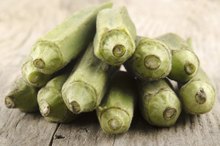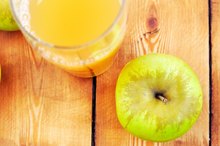Pineapple & Tuna Fish Diet
The pineapple and tuna fish diet is limited to three days, with the goal of quickly dropping a few pounds 1. If you follow the diet you will undoubtedly lose some weight. But you’ll quickly gain it back because you’re losing mostly water weight. While that’s a significant downside, this diet does have a few benefits. The combination of pineapple and tuna fish is rich in nutrients and has enough carbohydrates to keep you energized 1.
Pineapple and Tuna Diet Basics
As you would guess from its name, this diet consists of eating nothing but pineapple and tuna for three days 1. Some advocates claim you can lose up to 9 pounds during that time, but each person's results will vary. A description of the diet on the website of Dr. Rafael Bolio notes that the plan consists of eating 2 kilograms of pineapple spread throughout the day, plus 2 ounces to 4 ounces of tuna once a day 1. Two kilograms, or 2,000 grams, equals 12 cups of pineapple chunks. Four ounces of tuna is about 3/4 cup, according to the U.S. Department of Agriculture.
Calories and Weight Loss
Nutrition of Freeze Dried Okra
Learn More
Twelve cups of pineapple chunks and 4 ounces of light tuna packed in water contain a total of 1,088 calories. Even though this is low in calories, this diet does not get results in three days by cutting calories. If you reduce your daily intake by 500 calories, you’ll lose about 1 pound a week, reports the University of Michigan 6. Whether the pineapple and tuna diet means you’re eating 500 or 1,000 fewer calories each day, it will still take more than three days to see results 1. If you lose weight in three days, you've only lost water weight. Pineapples can boost the water loss because they're natural diuretics.
- Twelve cups of pineapple chunks and 4 ounces of light tuna packed in water contain a total of 1,088 calories.
- If you reduce your daily intake by 500 calories, you’ll lose about 1 pound a week, reports the University of Michigan 6.
Plenty of Nutrients
Twelve cups of pineapple supplies 260 grams of carbohydrates, including 195 grams of energy-providing sugar. The tuna ensures you’ll get about 60 percent of your daily protein and all of your daily requirement for vitamin B-12. Since you're eating such a large amount, the pineapple becomes a rich source of vitamin C, vitamin A, folate, potassium, magnesium, iron and calcium 1. With 28 grams of fiber in 12 cups of pineapple, women get an entire day’s fiber, while men consume 74 percent of their daily intake. If this is more fiber than you're used to eating, it may cause gas or diarrhea. With this much fiber it’s also important to drink 6 to 8 glasses of water, according to Oklahoma State University 7.
Considerations and Warnings
Citric Acid in Pineapple
Learn More
You will not consume too much mercury from the tuna if you limit the diet to three days. You can eat up to six servings per month of canned light tuna, reports the Natural Resources Defense Council 8. Albacore tuna is limited to half that amount because it has more mercury. Pineapples are the primary source of a substance called bromelain, which may interact with blood thinning medications. If you take these medications, do not start the diet until you consult your health care provider. Bromelain is a potent enzyme that breaks down proteins. As a result it may irritate your tongue or mouth. It can also upset your stomach or cause an allergic reaction. People who are allergic to latex are at a higher risk for being allergic to pineapples, reports the American Latex Allergy Association.
- You will not consume too much mercury from the tuna if you limit the diet to three days.
Related Articles
References
- Dr. Bolio: The Pineapple Diet
- USDA National Nutrient Database: Pineapple, Raw, All Varieties
- USDA National Nutrient Database: Fish, Tuna, Light, Canned in Water, Drained Solids
- University of Maryland Medical Center: Edema
- New York University Langone Medical Center: Proteolytic Enzymes
- University of Michigan: Weight Reduction
- Oklahoma State University: Dietary Fiber
- Natural Resources Defense Council: Consumer Guide to Mercury in Fish
- Pineapple, raw. FoodData Central. U.S. Department of Agriculture. Published April 1, 2019.
- The glycemic index. Diabetes Canada. 2020.
- Copper. National Institutes of Health Office of Dietary Supplements. 2019.
- Bromelain. National Institutes of Health. National Center for Complementary and Integrated Health. Updated 2016.
- Muhammad ZA, Ahmad T. Therapeutic uses of pineapple-extracted bromelain in surgical care - A review. J Pak Med Assoc. 2017;67(1):121-125.
- van Eekelen E, Geelen A, Alssema M, et al. Sweet snacks are positively and fruits and vegetables are negatively associated with visceral or liver fat content in middle-aged men and women. J Nutr. 2019;149(2):304-313. doi:10.1093/jn/nxy260
- Vitamin C Fact Sheet for Health Professionals. National Institutes of Health. Office of Dietary Supplements. Updated 2019.
- Anderson JJ, Nieman DC. Diet quality-the Greeks had it right!. Nutrients. 2016;8(10). doi:10.3390/nu8100636
- Chang TC, Wei PL, Makondi PT, Chen WT, Huang CY, Chang YJ. Bromelain inhibits the ability of colorectal cancer cells to proliferate via activation of ROS production and autophagy. PLoS ONE. 2019;14(1):e0210274. doi:10.1371/journal.pone.0210274
- Ask the Expert: Anaphylactic Reactions to Cherries, Strawberries, and Grapes. American Academy of Allergy Asthma and Immunology. Milwaukee, Wisc. 2020.
- Possible interactions with: bromelain. Penn State Hershey Milton S. Hershey Medical Center. 2011.
- Pineapples. SNAP-Ed connection U.S. Department of Agriculture.
- Selecting and serving produce safely. U.S. Food and Drug Administration.
Writer Bio
Sandi Busch received a Bachelor of Arts in psychology, then pursued training in nursing and nutrition. She taught families to plan and prepare special diets, worked as a therapeutic support specialist, and now writes about her favorite topics – nutrition, food, families and parenting – for hospitals and trade magazines.









